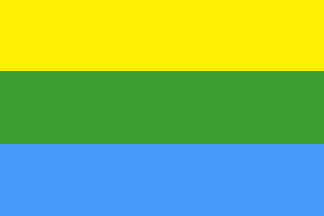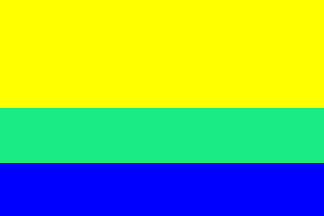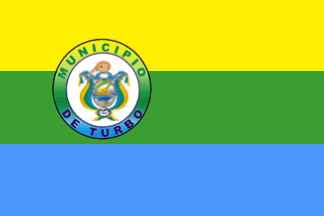 klaus-michael schneider
klaus-michael schneider
Keywords: antioquia | turbo | uraba |
Links: FOTW homepage | search | disclaimer and copyright | write us | mirrors

Last modified: 2021-08-26 by  klaus-michael schneider
klaus-michael schneider
Keywords: antioquia | turbo | uraba |
Links: FOTW homepage |
search |
disclaimer and copyright |
write us |
mirrors
 image by Ivan Sache, 12 December 2020
image by Ivan Sache, 12 December 2020
See also:
The municipality of Turbo (124,552 inhabitants in 2018; 30,550 ha) is located
on the Gulf of Urabá, 350 km north of Medellín, on the border with Panamá.
The foundation of the town of Turbo was ordered on 28 August 1840 by
President José Ignacio de Márquez. Turbo was erected a parish district in 1847
by President Tomás Cipriano de Mosquera.
Turbo was incorporated in 1848 to
the Antioquia department, to be transferred in 1850 to Chocó and in 1856 to El
Cauca state. Turbo was eventually re-incorporated to Antioquia by Law No. 17
promulgated on 10 April 1905.
Turbo is connected by sea with Cartagena,
Panamá and Colón, and by river Atrato with Quibdó. Voyage to Medellín required
15 days to one month on a muleteer's trail. The Sea Rod, initiated in 1926 and
inaugurated in 1954 by General Rojas Pinilla, eventually allowed terrestrial
communication and boosted the development of Turbo.
The port of Turbo is a
main spot of banana exportation.
http://www.turbo-antioquia.gov.co/
Municipal website
The flag of Turbo is horizontally divided yellow-green-celestial blue.
Photos
https://www.elcolombiano.com/documents/
http://culturadeturboantioquia.blogspot.com/2015/12/festividades.html
https://www.minuto30.com/antioquia/gobernador-e-llego-a-turbo-a-inaugurar-nuevas-uci-y-aseguro-que-falta-mucho-por-recorrer/1119790/
The descriptive text translates as follows.
The colors of the flag of
Turbo - yellow, green and blue - were proposed in the 1970s by the Basketball
Municipal Committee presided by Edwin Mathos. The Committee urgently needed a
symbol of the town, whose team had to represent the municipality in a
competition organized in Frontino. Mrs. Adalgiza Uribe, wife of the President,
was commissioned to sew the first copy of the flag.
The flag was made
official by Agreement No. 23 issued by the municipality on 10 August 1990.
The yellow stripe represents the municipality's sources of income: bananas,
plantains, cattle, and the coal and oil underground reserves.
The green
stripe represents the plant and animal ecological biodiversity, recognized as
among the richest on the Earth.
The blue stripe represents Gulf of Urabá,
which yielded to Turbo the nickname "Antioquia's best place" for its privileged
geostrategic location, and its deep-water port.
http://www.turbo-antioquia.gov.co/MiMunicipio/Paginas/Nuestros-Simbolos.aspx
Ivan Sache, 12 December 2020
 image by Ivan Sache, 12 December 2020
image by Ivan Sache, 12 December 2020
A copy of the flag had stripes in
relative proportions 2:1:1 and a much darker shade of blue, matching those of
the national flag.
Photo
https://www.dreamstime.com/editorial-photography-main-park-turbo-antioquia-colombia-ship-image92483912
Ivan Sache, 12 December 2020
 image by Ivan Sache, 12 December 2020
image by Ivan Sache, 12 December 2020
The Municipal Council uses the flag charged in the center with the coat of
arms surrounded by a tricolor ring inscribed "MUNICIPIO DE TURBO".
Video
https://www.youtube.com/watch?v=EJT20k0iN64
Photos
https://caracol.com.co/emisora/2019/05/03/medellin/1556885030_622526.html
https://la.network/mejoramiento-la-calidad-vida-uraba-depende-tambien-los-servicios-publicos/
https://www.facebook.com/alcaldiadeturbo2020/photos/2764120490472913
https://www.facebook.com/alcaldiadeturbo2020/photos/2719893994895563
https://www.facebook.com/alcaldiadeturbo2020/photos/2693674344184195
Ivan Sache, 12 December 2020
anttu.gif) image located by Ivan Sache, 12 December 2020
image located by Ivan Sache, 12 December 2020
The coat of arms of Turbo was designed by Denis González Leal, winner of a
contest organized in 1997 by the Cultural Extension Service.
In the upper
part is featured a black-bellied whistling duck (Dendrocygne autumnalis
Linnaeus, 1758), locally known as pisisí. Turbo was originally named Pisisí,
a translation from the Kuna name Mirtysukon, meaning "Pisisí Bay".
In the
lower part is featured a crab, Turbo's gastronomical symbol. The crab holds the flag
of Turbo that surrounds the shield and, in base, "1840", Turbo's foundation
year.
The central oval surrounds a "trasmayo" fishing net filled with fish,
representing Turbo's fishing tradition, in front of the Gulf of Urabá and river
Atrato, the municipality's great fishing resources.
The tri-ethnic man
represents the three ethnicities living in the municipality: Emberá Katío and
Kuna; Afro-Latinos, Afro-Caribbeans and Afro-Colombians from Chocó; and "cachacos"
coming from Colombia's central regions.
The banana leaves recall the source
of income of the municipality's smallholders.
The sun going down refers to
Darién, a Kuna world meaning "west, sundown", referring to the native
inhabitants of the western coast of the Gulf of Urabá.
http://www.turbo-antioquia.gov.co/MiMunicipio/Paginas/Nuestros-Simbolos.aspx
Municipal website